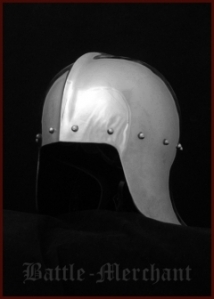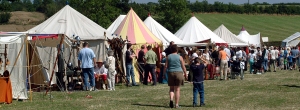Now there are a large number of options available to you with regards to finding where to buy your re-enactment equipment. Chances are, this being an age where the internet is a pretty dominant part of Western life, your first port of call will be looking for a merchant online. Tapping in “re-enactment supplies” or “re-enactment equipment” into your search engine of choice will quickly bring up a large array of websites all of which will be able to offer you the things you need to go medieval (or Roman, Napoleonic, Civil War and so on). Remember that you don’t have to restrict yourself to re-enactment supply websites either; any good LARP (Live-Action Roleplay) website will also have a good number of costumes and props available to help bulk out your kit. My Saxon tunic and a leather-bound book I sometimes sketch in while on field were both bought from LARP suppliers.
Online retailers are ideal for quickly and reliably giving you pre-made goods that are made to traders’ standards, which as a new re-enactor you’re going to want to focus on at first. While something tailor-made to a design of your own would be very nice indeed, that will be both expensive, time consuming and difficult to find until you have a better idea of the people who make equipment on commission. As a newbie, you just want kit that is both kind to your wallet and looks good on you. Plus, most of the people you’d get tailor made equipment from will be found during shows, so the internet is going to be your first port of call during the winter season or in between events.
The websites I usually look to for re-enactment equipment include Battle Merchant, Jelling Dragon, Get Dressed for Battle and the Re-enactmentsupplies.co.uk. The latter two will be among the first websites you’ll see if you look up re-enactment supplies on Google, whereas Jelling Dragon and Battle Merchant were referred to me by other re-enactors. Dark Blade is also a good website for cloth kit, belts and accessories. Battle Merchant is actually a German company, but although their prices are initially listed as Euros they have a handy little sidebar that can convert them into pounds stirling, so you don’t need to work anything out yourself. Those like me who are absolutely toxic with maths can breathe a sigh of relief.
Whereas Battle Merchant, Re-enactmentsupplies.co.uk and Get Dressed for Battle cater to a wide variety of time periods, Jelling Dragon focuses exclusively on Viking crafts, costume and weapons. That said, the work they do is absolutely stunning, and it’s quite easy to adapt it to Anglo-Saxon kit in general. After all, they would have been trading with Nordic countries to begin with, and after the 9th century the Danelaw, and subsequent Danish and Norwegian invasions would have seen a lot of Scandinavian influence exerted on Anglo-Saxon people. Their goods are not unreasonably priced, either, although when you do see a high price tag you can be assured that it’s worth the cost.
One thing you’ll immediately notice with these websites is that the equipment is pretty expensive. Most stuff you’ll be buying will be around or over the £50 mark, while weapons and armour will quickly see you into the £100 mark and beyond. Alas, this is something true to re-enactment in general and websites have the added expense of shipping that you’ll need to be aware of. Spend some time flicking between the suggested websites to find a price that agrees with you.
Another place to look at would be eBay; however that carries its own advantages and disadvantages. For example, bids being lost at the last second (often literally) by someone who places in a higher price than you just before the timer runs out. You’re also more likely to run aground of dodgey equipment or accidentally buying something that turns out not to be what you expected. Once, a member of the Free Men placed a bid for something that he believed to be an authentically made war horn, only to find out upon its arrival that it was more of a novelty party blower. Needless to say the duck-like squawk it emitted inspired neither fear nor bravery.
Stalls are the next place to look for and have a significant advantage over online retailers in that you can actually see, handle and discuss what you’re about to buy with the stall owner. This allows you to work out in advance how well it will compliment your outfit, any adjustments you might need to make, and discover flaws that you would not be able to discern over the internet. It’s not uncommon to see and purchase things you’d never have considered having, as well. Most stalls will also attend multiple shows throughout the year, so even if you can’t afford something now you can easily check with the stall owner about where they’ll be next, and save up to purchase it there if it’s a show you’ll be attending as well. If you get on particularly well with them and know you’re reliable, they may even offer to place it to one side for you to stop other people from buying it.
Second hand stalls are a good place to find cheap equipment for those whose budgets are tight. You’ll often find bargain bins filled with things such as drinking horns, old shoes, gauntlets or even swords and helmets, most of which will be at or under £50 in price.
This also brings along the great medieval mercantile tradition of haggling, which is something that some stalls are quite happy to engage in. Remember that most stall owners want to get rid of the things they’re selling and want to make a return on the money they’d have spent setting up shop at that event. Not only have they had to shell out securing their right to sell things during the show, but they’d probably have spent a lot just on petrol as well. As such if you spot a nice cloak or a tankard that you’d like, but aren’t quite sure of the price, try to offer something at, say, £5 or £10 less. You’re more likely to be successful during the last hours on Sunday, as there’ll be a greater desire to offload as much stock as possible before leaving. Having a good rapport or connections with people the stall owner might know also helps.
Of course, do not assume that every stall owner will be open to haggling. Indeed it would not be unreasonable for them to consider it to be very rude, as it suggests that you think they’re overcharging for their goods. If ever you’re uncertain, just look around the stall in case there’s a sign that says something along the lines of “Listed prices are final”, or else just ask. Barter is common enough amongst re-enactors that they’d probably not take offense.
If you’re really strapped for cash and find that looking at first-hand equipment does nothing but make you wish for greater financial independence, then there’s still an alternative.
Charity shops are a good, cheap and easy to find source of small pieces of clothing and equipment that you may not automatically consider. A cheap pair of plain brown leather shoes, although they won’t impress people who strive for authenticity, will usually pass unnoticed by the Average Public. Likewise a cheap pair of nicely-patterned curtains can easily be repurposed to make a Suitably Gay medieval doublet. Have a browse, and use your imagination and initiative. Doing so may save you a bundle that you would otherwise have spent on something you may not have easily been able to afford.
Remember that your group will (or should) want you to get the most out of your hobby and won’t stand idly by while you’re languishing from kit woes. As well as loaning kit out to you, many older members may be willing to sell you their equipment second-hand. As they’re a part of your group, they should also be willing to offer you a very generous discount, because by helping you they’re helping the group at large. If you look good, the group looks good. Suddenly, a helmet that would have cost you £65 online or at a stall will only cost you half that much. It’s not beyond the realms of possibility for them to waive payment entirely, or substitute it for drinks or a favour, but don’t expect that. As a rule of thumb, always assume that you’ll have to pay.
Another thing they’ll be able to do is to point you in the direction of cheap stalls during shows, or else work their own contacts to try and get you a better deal. Over the time re-enactors will come to know and make connections with a wide variety of people, and as is often the case who you know can be far more rewarding that what you know.
Once your basic kit is sorted you can start looking for more expensive, personal kit, such as swords forged especially for you, costumes made to your specifications or even your own canvas tent so you don’t have to put up with everyone’s snoring and flatulence. It does not take long before your bare-bones chainmail-and-helmet job is accentuated with a fur cloak, rosaries, a drinking horn, a seax or a specially designed tabard showing off your family’s crest. Remember to try and space out your purchases as much as you can, and not to fall to the temptation of thinking that you need to look fantastic straight out of the box. The time it takes for you to acquire even the most basic elements of your kit is time you’re spending training, and learning the ropes of your group and the hobby. Once you’re properly equipped and start looking good, you should be trained and confident enough to start taking larger roles during the show, where your new kit and training both can best be shown off.




Recent Comments